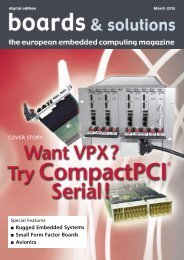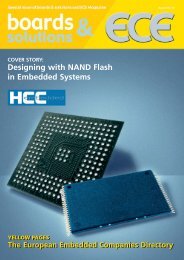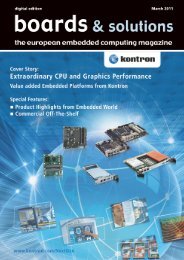in PDF Format - Embedded-Control-Europe.com
in PDF Format - Embedded-Control-Europe.com
in PDF Format - Embedded-Control-Europe.com
You also want an ePaper? Increase the reach of your titles
YUMPU automatically turns print PDFs into web optimized ePapers that Google loves.
ATCA, MTCA & AMC<br />
Figure 3. Example of a large <strong>in</strong>dustrial control system <strong>in</strong> customized ATCA form factor<br />
Figure 3 shows an <strong>in</strong>dustrial control system<br />
that consists of custom ATCA I/O blades. The<br />
I/O blades are grouped <strong>in</strong>to clusters with each<br />
cluster serv<strong>in</strong>g one particular set of I/O devices<br />
such as sensors, scanners, or cameras. The<br />
blades have an AMC bay support<strong>in</strong>g one or<br />
more AMC CPUs per cluster. Note that the<br />
CPU AMC used could be any one of many<br />
standard off-the-shelf processor AMCs, such<br />
as the GE Intelligent Platform ASLP11. This<br />
CPU enumerates the PCIe tree of a particular<br />
I/O cluster. Consider<strong>in</strong>g a 14-slot ATCA chassis,<br />
up to four such I/O clusters can be <strong>in</strong>terconnected<br />
us<strong>in</strong>g one I/O blade as a ma<strong>in</strong> PCIe<br />
switch. All PCIe connections are via a customized<br />
Zone 1 and Zone 2 backplane. If<br />
more <strong>com</strong>pute power is needed, a standard<br />
off-the- shelf ATCA SBC, such as the GE<br />
A10200 dual Westmere blade, can be added to<br />
the system. Most SBCs on the market route<br />
PCIe to the Zone 3 connector for connectivity<br />
to a RTM; this connection can be reused by<br />
creat<strong>in</strong>g a custom Zone 3 backplane.<br />
Note that <strong>in</strong> figure 3, only one custom ATCA<br />
blade design is needed. To further cost-optimize<br />
a blade, implementers can take advantage of<br />
the fact that there are p<strong>in</strong>-<strong>com</strong>patible PCIe<br />
switches support<strong>in</strong>g different numbers of ports.<br />
Once aga<strong>in</strong>, this implementation takes advantage<br />
of PCIe features, such as non-transparent<br />
ports and high performance. A gen 3 x8 PCIe<br />
port can support up to 64 Gbits/s throughput,<br />
which exclud<strong>in</strong>g overheads still delivers approximately<br />
54 Gbits/s effective data throughput<br />
with only a couple of hundred nanoseconds<br />
latency and very low CPU utilization.<br />
Portable systems, be it a medical scanner (ultrasound,<br />
etc.) or <strong>in</strong>dustrial tester, require a<br />
<strong>com</strong>pact and flexible form factor. Such systems,<br />
be<strong>in</strong>g portable <strong>in</strong> nature, also depend on shock<br />
and vibration immunity. Typically, a portable<br />
scanner consists of two dist<strong>in</strong>ct elements: an<br />
acquisition subsystem consist<strong>in</strong>g of sensors or<br />
cameras, their <strong>in</strong>terface card, and a process<strong>in</strong>g<br />
element, and a display subsystem consist<strong>in</strong>g<br />
of a CPU and high-performance graphic cards<br />
and displays. Both subsystems need to be <strong>in</strong>-
















